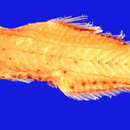Comprehensive Description
provided by Smithsonian Contributions to Zoology
Nannobrachium wisneri
Lampanyctus ater.—Norman, 1930:331 [in part] [South Atlantic].—[Not Tåning, 1928.]
Lampanyctus intricarius.—Norman, 1930:330 [in part, fide McGinnis, 1982] [South Atlantic].—[Not Tåning, 1928.]
Lampanyctus niger.—Norman, 1930:331 [in part] [South Atlantic].—[Not Günther, 1887.]
Lampanyctus sp.—Norman, 1930:331 [South Atlantic].
Lampanyctus achirus.—Bussing, 1965:203–204 [in part] [midwaters of Peru-Chile Trench].—Nafpaktitis and Nafpaktitis, 1969:45–46 [in part] [description, South Indian, fig. 55].—Craddock and Mead, 1970:28 [in part] [southeast Pacific].—Parin, 1971:82, 87, 89, 90 [?in part?] [Peru Current].—Parin et al., 1974:106 [?in part] [southwest Atlantic].—Rubies, 1985: 578–584 [?in part?] [Valdivia Bank off Namibia, gill raker numbers].—[Not Andriashev, 1962.]
Lampanyctus cf. achirus.—Hulley, 1972:225 [in part?] [description, South Atlantic].—[Not Andriashev, 1962.]
Lampanyctus ?achirus.—Hulley, 1981:184–185 [description, southwest Atlantic].—[Not Andriashev, 1962.]
Lampanyctus sp. A.—McGinnis, 1982:43–45, 66 [in part?] [distribution south of 30°S, relationships, zoogeography].
Lampanyctus (Lampanyctus) achirus.—Bekker, 1983:86–87, 198–199 [in part] [key, description, distribution].—[Not Andriashev, 1962.]
Lampanyctus sp. B.—Hulley, 1986b:243 [zoogeography]; 1986c:310, fig. 86.89 [description, South Africa, figure].
TYPE SPECIMENS.—Holotype: Female (?), 57 mm, MCZ 55478 (RHB 2229), R.V. Atlantis II, sta 60, 35°50′S, 2°16′W, 23 April 1971, depth 600–650 m.
Paratypes: LACM 11-259, 7 (30–37 mm); LACM 11-273, 6 (30–85 mm); MCZ 55478 (RHB 2229), 2 (34–35 mm); SIO 58–256, 1 (64 mm); SIO 61-46, 31 (34–71 mm); SIO 63-542, 2 (37–57 mm); SIO 63-544, 2 (34–60 mm); SIO 69-321, 22 (25–69 mm); USNM 209390, 139 (20–65 mm); USNM 209395, 31 (25–65 mm); USNM 209400, 21 (38–68 mm); WHOI 13–41, 4 (43–54 mm).
COMPARATIVE DIAGNOSIS.—Nannobrachium wisneri (Figure 22) can be distinguished from N. crypticum, N. achirus, and N. phyllisae by its gill raker count (lower than in N. achirus and N. phyllisae, higher than in N. crypticum) and by the virtually complete lack of pectoral fins in specimens larger than small juvenile stages (about 35 mm). It can be most easily distinguished from N. hawaiiensis by the higher number of infracaudal luminous gland scales, lateral line organs, and vertebrae (Table A11). Nannobrachium wisneri can be separated from all other species of Nannobrachium by the combination of characters in Table 1, but especially by the virtual absence of pectoral fins.
DESCRIPTION.—Counts are based on up to 26 specimens and are given in Tables A2–A8, A11. Counts for the holotype are D 15, A 19, P1, none, GR 4+11, tooth patches 9, AO 8+6 (L), 7+7 (R), SC/IC 4(?)/7(?), LL 36, V 15+20.
Proportions: Given in Table 18. Holotype measurements (in mm) as follows: SL 57, HD 9.1, PDD 8.1, CPD 5.1, CPL 11.1, PADL 11.0, PDL 29.2, PPL 22.9, PANL 30.3, PAL 7.9, HL 15.8, UJL 12.1, SOL 3.0, ED 4.0, SGL 3.8 (damaged), IGS 9.9, IGEL 9.9, AFB 14.6, DFB 11.9, AF 4.
Fins: Origin of anal fin under or before vertical through center of base of dorsal fin (before vertical in holotype). Pectoral fins completely lacking in subadult and adult stages; vestigial in small juveniles (less than about 30 mm). Fin rays present but buried in the skin in larger juveniles (approximately 30–35 mm). Adipose-fin base over end of anal-fin base.
Luminous Organs: PLO typically more than 2 photophore diameters below lateral line (nearly 3 diameters in holotype). PO4 approximately on, or slightly below, level of PVO2 and above PO3. PVO1–2 interspace wide, that distance 1–3 times into PVO2-PLO interspace (about 1 times in holotype). SAO1 above VO3 but somewhat forward of vertical from center of VO3. SAO2 midway above interspace between VO4 and AOa1 but variable in position (closer to vertical from AOa1 in holotype). SAO3 above AOa1. AOa1 not noticeably or only slightly depressed; AOa1–2 interspace not noticeably enlarged. AOp1 above end of anal-fin base (behind base on left side of holotype). Prc slightly separate from AOp; Prc1–2 approximately on horizontal line, but Prc2 often slightly lower; Prc3 below Prc4 but slightly in advance of vertical from center of Prc4. Supracaudal and infracaudal luminous glands well developed, rarely having single separated luminous scale preceding solid infracaudal gland. Possible traces of secondary photophores on back in similar position to those of N. achirus.
Size: Nannobrachium wisneri probably does not exceed 90 mm in length. The largest specimen examined for this study was 88 mm.
Material: 1020 (20–83 mm) specimens, excluding type material.
VARIATION.—Nannobrachium wisneri is nearly circumglobal in Subtropical Convergence waters (Figure 19). The gap in its range south, and especially east, of Australia appears to be real, not an artifact of sampling effort. Particular attention was paid to comparing specimens from the Atlantic, Pacific, and Indian oceans, but no consistent meristic differences were found, except the one Atlantic specimen discussed above.
ETYMOLOGY.—It is an honor and a pleasure to name this species for Robert L. Wisner of the Scripps Institution of Oceanography in recognition of his contributions to the systematics of myctophids and other oceanic fishes.
- bibliographic citation
- Zahuranec, Bernard J. 2000. "Zoogeography and systematics of the lanternfishes of the genus Nannobrachium (Myctophidae:Lampanyctini)." Smithsonian Contributions to Zoology. 1-69. https://doi.org/10.5479/si.00810282.607

